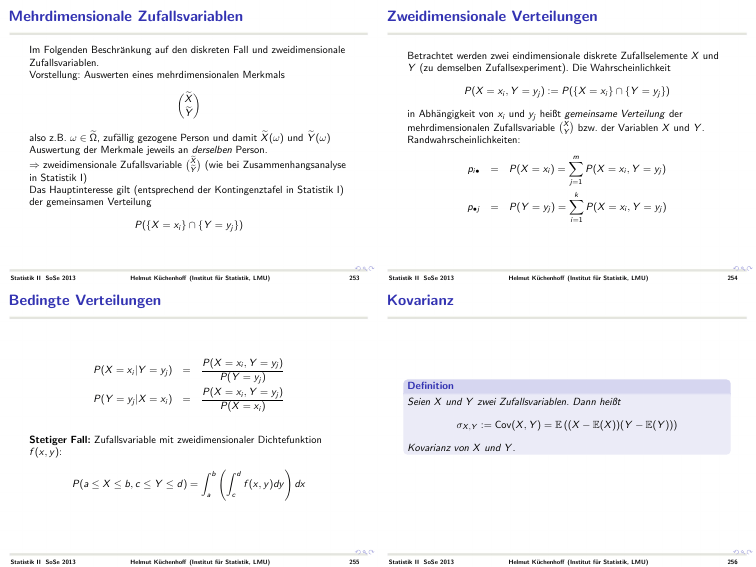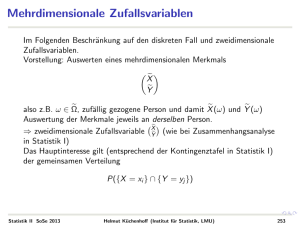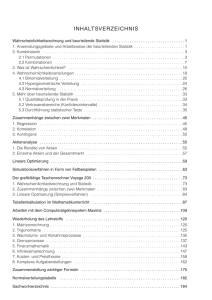Mehrdimensionale Zufallsvariablen Zweidimensionale Verteilungen
Werbung

Mehrdimensionale Zufallsvariablen
Zweidimensionale Verteilungen
Im Folgenden Beschränkung auf den diskreten Fall und zweidimensionale
Zufallsvariablen.
Vorstellung: Auswerten eines mehrdimensionalen Merkmals
Betrachtet werden zwei eindimensionale diskrete Zufallselemente X und
Y (zu demselben Zufallsexperiment). Die Wahrscheinlichkeit
P(X = xi , Y = yj ) := P({X = xi } ∩ {Y = yj })
e
X
e
Y
in Abhängigkeit von xi und yj heißt gemeinsame Verteilung der
mehrdimensionalen Zufallsvariable YX bzw. der Variablen X und Y .
Randwahrscheinlichkeiten:
e zufällig gezogene Person und damit X
e (ω) und Y
e (ω)
also z.B. ω ∈ Ω,
Auswertung der Merkmale jeweils an derselben Person.
e
X
⇒ zweidimensionale Zufallsvariable Ye (wie bei Zusammenhangsanalyse
in Statistik I)
Das Hauptinteresse gilt (entsprechend der Kontingenztafel in Statistik I)
der gemeinsamen Verteilung
pi•
= P(X = xi ) =
Helmut Küchenhoff (Institut für Statistik, LMU)
p•j
253
Bedingte Verteilungen
= P(Y = yj ) =
Statistik II SoSe 2013
k
X
P(X = xi , Y = yj )
i=1
Helmut Küchenhoff (Institut für Statistik, LMU)
254
Kovarianz
P(X = xi |Y = yj )
=
P(Y = yj |X = xi )
=
P(X = xi , Y = yj )
P(Y = yj )
P(X = xi , Y = yj )
P(X = xi )
Definition
Seien X und Y zwei Zufallsvariablen. Dann heißt
σX ,Y := Cov(X , Y ) = E ((X − E(X ))(Y − E(Y )))
Stetiger Fall: Zufallsvariable mit zweidimensionaler Dichtefunktion
f (x, y ):
!
Z
Z
b
P(a ≤ X ≤ b, c ≤ Y ≤ d) =
Statistik II SoSe 2013
P(X = xi , Y = yj )
j=1
P({X = xi } ∩ {Y = yj })
Statistik II SoSe 2013
m
X
d
f (x, y )dy
a
Kovarianz von X und Y .
dx
c
Helmut Küchenhoff (Institut für Statistik, LMU)
255
Statistik II SoSe 2013
Helmut Küchenhoff (Institut für Statistik, LMU)
256
Rechenregeln
Korrelation
Cov(X , X ) = Var(X )
Definition
Cov(X , Y ) = E(XY ) − E(X ) · E(Y )
Zwei Zufallsvariablen X und Y mit Cov(X , Y ) = 0 heißen unkorreliert.
Cov(X , Y ) = Cov(Y , X )
Stochastisch unabhängige Zufallsvariablen sind unkorreliert. Die
Umkehrung gilt jedoch im allgemeinen nicht.
Mit X̃ = aX X + bX und Ỹ = aY Y + bY ist
Cov(X̃ , Ỹ ) = aX · aY · Cov(X , Y )
Vergleiche Statistik I: Kovarianz misst nur lineare Zusammenhänge.
Var(X + Y ) = Var(X ) + Var(Y ) + 2 · Cov(X , Y )
Statistik II SoSe 2013
Helmut Küchenhoff (Institut für Statistik, LMU)
257
Korrelationskoeffizient
Statistik II SoSe 2013
Helmut Küchenhoff (Institut für Statistik, LMU)
258
Eigenschaften des Korrelationskoeffizienten
Mit X̃ = aX X + bX und Ỹ = aY Y + bY ist
Definition
Gegeben seien zwei Zufallsvariablen X und Y . Dann heißt
|ρ(X̃ , Ỹ )| = |ρ(X , Y )|.
−1 ≤ ρ(X , Y ) ≤ 1.
Cov(X , Y )
p
ρ(X , Y ) = p
Var(X ) Var(Y )
|ρ(X , Y )| = 1 ⇐⇒ Y = aX + b
Korrelationskoeffizient von X und Y .
Statistik II SoSe 2013
Helmut Küchenhoff (Institut für Statistik, LMU)
Sind Var(X ) > 0 und Var(Y ) > 0, so gilt ρ(X , Y ) = 0 genau dann,
wenn Cov(X , Y ) = 0.
259
Statistik II SoSe 2013
Helmut Küchenhoff (Institut für Statistik, LMU)
260
Beispiel: Chuck a Luck
Berechnungen
X1 Gewinn, wenn beim ersten Wurf ein Einsatz auf 1 gesetzt wird.
X6 Gewinn, wenn beim ersten Wurf ein Einsatz auf 6 gesetzt wird.
Kovarianz zwischen X1 und X6 :
(x1 , x6 )
(−1, −1)
(−1, 1)
(1, −1)
(−1, 2)
(2, −1)
Statistik II SoSe 2013
P(X1 = x1 , X6 = x6 )
64
216
48
216
48
216
12
216
12
216
(x1 , x6 )
P(X1 = x1 , X6 = x6 )
(−1, 3)
(3, −1)
(1, 1)
(1, 2)
(1, 2)
Helmut Küchenhoff (Institut für Statistik, LMU)
⇒
1
216
1
216
24
216
3
216
3
216
E (X1 · X6 ) = −50/216 = −0.23148
Cov(X1 , X6 ) = −0.23148 − (−0.0787) · (−0.0787) = −0.23768
X1 und X6 sind negativ korreliert.
261
Statistik II SoSe 2013
Helmut Küchenhoff (Institut für Statistik, LMU)
262


